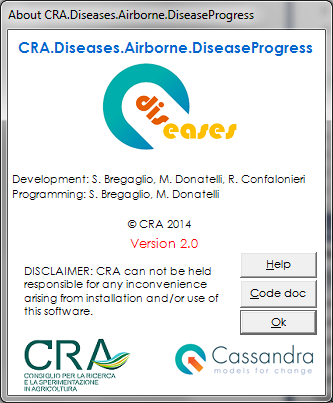OBJECTIVE
The DiseaseProgress component implements an epidemiological model to simulate the disease progress rate of a polycyclic fungal disease during the cropping season, as a function of (i) the agro-meteorological conditions experienced by the crop and (ii) of the host-pathogen interactions. This component is the evolution of the first realization within the EU FP6 SEAMLESS project (Salinari et al., 2009).

Form about of the DiseaseProgress component
RATIONALE
Mathematical modelling of crop diseases started in the '60s with the works of van der Plank (1963), who developed the first models to simulate the temporal development of plant epidemics and have drawn the guidelines of plant disease modelling (Campbell and Madden, 1990; McCartney, 1997). Further developments of this branch of pathology led to the formalization of models to estimate disease severity and yield losses as a function of different factors such as weather, varietal resistance and crop management practices (van Maanen and Xu, 2003).
One of the most common approach followed in computer simulation of plant diseases is the implementation of Linked Differential Equations (LDE) into Susceptible-Exposed-Infected-Removed (SEIR) models. According to this approach, the plant host tissue is classified into non-overlapping categories such as healthy, latently infected, visible but not sporulating, infectious and sporulating and senescent, characterized by old and no longer sporulating lesions (Jeger, 2000).
The parameters in SEIR model usually drive functions of external factors such as air temperature, leaf wetness, wind speed, rain and air relative humidity (Ferrandino, 1993)The level of host resistance and the variable susceptibility of host tissue during the crop growth are important factors to be considered in modelling (Shtienberg, 2000), since they affect the rate of disease development during the cropping season.
Created with the Personal Edition of HelpNDoc: Full-featured EPub generator